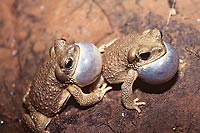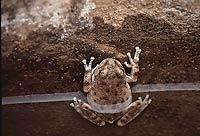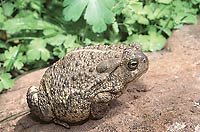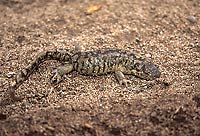Spring’s trumpet may be the cacophony of wild bird calls as neotropical migrants and “the locals” get engaged with the breeding season. But it isn’t just the birds that are singing.
Alongside the calls of their distant avian cousins are the deep sonorous “jug-a-rums” of the invasive bullfrog Red-spotted toads are appropriately named for their dimpled skin is covered in raised, red warts. Smaller than leopard frogs, these toads can congregate at a desert pool after a rainstorm, the males’ bleating calls luring females and competitors. The red-spotted toads call is a long trill that can be heard from far away. Canyon bottoms, potholes, stock tanks, and tinajas are all fair game as breeding sites for these toads.
These red-spotted toads, like other amphibians, race against time – the hatching of eggs and development of tadpoles into adults before their watery home evaporates and dries up.
 In addition to the red-spotted toads, there are also canyon treefrogs able to cling to sandstone rims or canyon walls due to specialized sucker-cup like toes. These treefrogs make a loud, guttural sheep-like bleating sound to attract mates to their watery domain. Though able to climb, the canyon treefrog generally finds a rocky crevice to hide out during the day.
In addition to the red-spotted toads, there are also canyon treefrogs able to cling to sandstone rims or canyon walls due to specialized sucker-cup like toes. These treefrogs make a loud, guttural sheep-like bleating sound to attract mates to their watery domain. Though able to climb, the canyon treefrog generally finds a rocky crevice to hide out during the day.
Another amphibian found in canyon drainages or forest ponds is the Western toad. Its body is gray to greenish in color, with a whitish dorsal stripe running the length of its back. Dark spots pattern its back, as well. These toads lack a vocal sac like the inflated one the red-spotted toad has. There is some controversy about their advertising calls which is a series of calls that resembles the song of a northern saw-whet owl. Some researchers believe these toads have lost their mating call.
 Woodhouse’s toads, which may be confused with the Western toad, resembles a grayish-brown hockey puck with a ventral white stripe. A French herpetologist named the newly discovered toad in 1854 after physician and naturalist Samuel Washington Woodhouse. Covered with dark spots, these toads have 2 long parotid glands which are glands located near the shoulder that produce bufotoxins to ward off predators. Contrary to popular myths, a human doesn’t develop warts if they touch a toad nor does a light kiss turn them into a handsome prince. Eggs laid in gelatinous strings that are anchored to a piece of vegetation.
Woodhouse’s toads, which may be confused with the Western toad, resembles a grayish-brown hockey puck with a ventral white stripe. A French herpetologist named the newly discovered toad in 1854 after physician and naturalist Samuel Washington Woodhouse. Covered with dark spots, these toads have 2 long parotid glands which are glands located near the shoulder that produce bufotoxins to ward off predators. Contrary to popular myths, a human doesn’t develop warts if they touch a toad nor does a light kiss turn them into a handsome prince. Eggs laid in gelatinous strings that are anchored to a piece of vegetation.
Tiger salamanders are another amphibious creature that lives in Canyon Country. These salamanders may be  terrestrial, hiding beneath forest floor litter or lurking in underground burrows during the day. When the breeding season is on, they, too, head for water. Their larval stage is completely aquatic, sprouting gills to breathe underwater. Some larvae metamorphose into adults quickly while others grow limbs and become adult-sized before they metamorphose. These creatures, often called “waterdogs,” resemble adults but still have gills. In areas of poor-quality habitat, the waterdog stage becomes the sexually mature phase of the salamander’s life cycle.
terrestrial, hiding beneath forest floor litter or lurking in underground burrows during the day. When the breeding season is on, they, too, head for water. Their larval stage is completely aquatic, sprouting gills to breathe underwater. Some larvae metamorphose into adults quickly while others grow limbs and become adult-sized before they metamorphose. These creatures, often called “waterdogs,” resemble adults but still have gills. In areas of poor-quality habitat, the waterdog stage becomes the sexually mature phase of the salamander’s life cycle.
Besides being harbingers of environmental health, steadfast predators of mosquitoes, aquatic insects, invertebrates, and other prey, amphibians also hold keys to human health such as enzymes produced by Northern leopard frogs that have found their way into cancer treatments for brain tumors. Yes, these creatures are toadally cool.